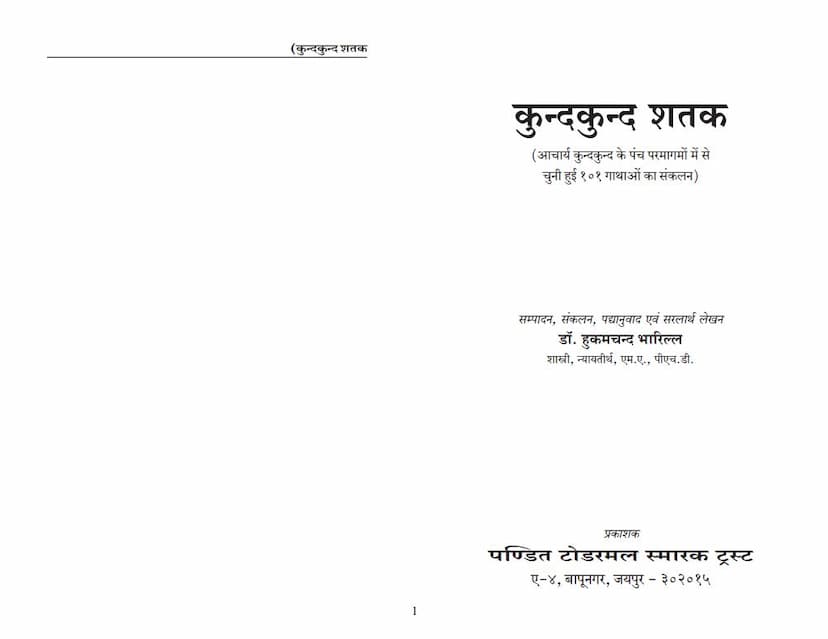Kundkunda Shatak
Added to library: September 2, 2025

Summary
Here's a comprehensive summary of the provided text from "Kundkunda Shatak" by Hukamchand Bharilla, focusing on the core teachings presented in the selected verses:
Overall Purpose and Theme:
The "Kundkunda Shatak" is a compilation of 101 verses (Gathas) selected from the "Panch Paramgams" of Acharya Kundkund. The book, edited and explained by Dr. Hukamchand Bharilla, aims to distill the essence of Kundkund's profound teachings on the Jain path to liberation. The overarching theme revolves around the supremacy of the true self (Ātmā), the paramount importance of right faith (Samyakdarshan), and the path of self-realization through right knowledge (Samyagjnana) and right conduct (Samyakcharitra).
Key Teachings and Concepts:
-
The True Self as the Ultimate Refuge:
- The verses repeatedly emphasize that the soul (Ātmā) is the only true refuge. The Panch Parmeshthi (Arhat, Siddha, Acharya, Upadhyaya, Sadhu) are seen not as external deities, but as states of the soul itself.
- The true self is described as pure, formless, unknowable by senses, containing the quality of consciousness, and distinct from all other substances. It is characterized by freedom from desires, anger, pride, and all impurities.
-
The Supremacy of Right Faith (Samyakdarshan):
- Foundation of Dharma: Samyakdarshan is consistently presented as the root of all Dharma. Without it, all other efforts like austerities, vows, and even the outward appearance of asceticism are considered futile.
- Destruction of Karma: Right faith is the catalyst for the destruction of the eight types of karma, leading to liberation.
- Unwavering Devotion: Even in dreams, one should not compromise their right faith. Those who maintain it are considered blessed, brave, and wise.
- The True Nature of Reality: Samyakdarshan involves understanding the true nature of the soul and other entities (Jiva, Ajiva, etc.) as they are in reality (Bhutarth Naya).
-
The Path of Self-Realization:
- Knowledge (Jnana): The soul is described as being of the nature of knowledge. True knowledge is the understanding of the self. Knowing the pure self leads to becoming pure.
- Conduct (Charitra): Right conduct involves renouncing passions like attachment, aversion, anger, pride, deceit, and greed. It is the practice of virtue and the purification of the soul.
- Austerities (Tapas) and Vows (Vrata): These are considered meaningful only when they are rooted in right faith and accompanied by self-restraint. Austerities performed without right faith are called "childish austerities" and do not lead to liberation.
- Meditation (Dhyana): Meditating on the pure self is crucial for burning away karmic impurities and achieving liberation.
-
The Distinction Between Nayas (Perspectives):
- Nishchaya Naya (Ultimate Truth): This perspective focuses on the inherent nature of the soul, its purity, and its self-sufficiency. It negates the reality of external substances in relation to the soul.
- Vyavahar Naya (Conventional Truth): This perspective explains reality in a way that is understandable in the world, acknowledging conventional distinctions and practices. However, it is ultimately subservient to the Nishchaya Naya. The text clarifies that behavior described through Vyavahar Naya (like the soul having knowledge and conduct) is not the ultimate reality but a way to point to the ultimate truth.
- The Interplay: The text highlights that Vyavahar Naya is necessary to convey the teachings of Nishchaya Naya, but one must ultimately rely on Nishchaya Naya for liberation.
-
The True Nature of Asceticism and Conduct:
- Inner Purity is Key: True asceticism (Shramanpana) is not just about outward renunciation (like nudity) but about inner purity, freedom from passions, and self-control.
- Futility of Outer Form Without Inner Substance: Nakedness, austerities, vows, and even the outward signs of an ascetic are meaningless without the internal purification of faith, knowledge, and conduct.
- Attachment is Binding: Both good (punya) and bad (papa) karma are binding. Attachment to either leads to continued transmigration. True liberation comes from detachment from all karma.
- Indriya Sukha (Sensual Pleasure) is Misery: Pleasures derived from the senses are temporary, dependent on external factors, cause suffering, and lead to bondage. They are not true happiness.
-
The Importance of Scripture and Knowledge:
- Jain Scriptures as a Guide: The teachings of the Tirthankaras, compiled by Ganadharas, are essential for understanding the path to liberation.
- Study and Reflection: Studying scriptures is crucial for dispelling ignorance and achieving self-knowledge. It helps in understanding the true nature of reality and dispelling attachment and aversion.
- Avoiding Dogmatic Debates: Since beings, their karma, and their understanding vary, engaging in futile debates about different viewpoints is discouraged.
-
The Nature of Karma:
- All Karma is Binding: Both positive (punya) and negative (papa) karmas bind the soul. Attachment to any karma is a cause for continued suffering.
- The Soul is Not the Doer: The soul does not cause or experience the results of karma. Karma operates according to its own nature. The soul is merely a witness.
- Attachment to Results: The real binding factor is the attachment and aversion towards the results of actions, not the actions themselves.
In essence, "Kundkunda Shatak" serves as a profound guide, drawing from the timeless wisdom of Acharya Kundkund, to direct the aspirant towards self-discovery, the realization of the soul's inherent purity, and the ultimate goal of liberation through unwavering right faith, knowledge, and conduct. It emphasizes that true religion lies in the inner transformation of the soul, not in outward appearances or rituals alone.